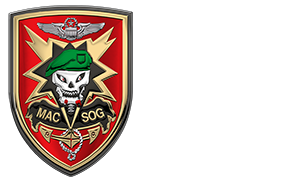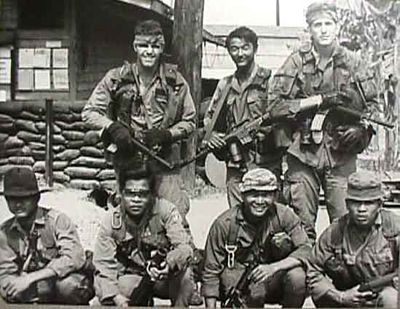Shining Brass
Operation Shining Brass
On 21 September 1965, the Pentagon authorized MACV-SOG to begin cross-border operations in Laos in areas contiguous to South Vietnam’s western border. MACV had sought authority for the launching of such missions (Operation Shining Brass) since 1964 in an attempt to put boots on the ground in a reconnaissance role to observe, first hand, the enemy logistical system known as the Ho Chi Minh Trail (the Truong Son Road to the North Vietnamese). MACV, through the Seventh Air Force, had begun carrying out a strategic bombardment of the logistical system in southern Laos in April (Operation Steel Tiger) and had received authorization to launch an all-Vietnamese recon effort (Operation Leaping Lena) that had proven to be a disaster. U.S. troops were necessary and SOG was given the green light.
On 18 October 1965, MACV-SOG conducted its first cross-border mission against target D-1, a suspected truck terminus on Laotian Route 165, 15 miles (24 km) inside Laos. The team consisted of two U.S. Special Forces soldiers and four South Vietnamese. The mission was deemed a success with 88 bombing sorties flown against the terminus resulting in multiple secondary explosions, but also resulted in SOG’s first casualty, Special Forces Captain Larry Thorne in a helicopter crash. William H. Sullivan, U.S. Ambassador to Laos, was determined that he would remain in control over decisions and operations that took place within the supposedly neutral kingdom.
The Laotian Civil War that raged intermittently between the communist Pathet Lao (supported by People’s Army of Vietnam (PAVN) troops) and the Royal Lao armed forces (supported by the CIA-backed Hmong army of General Vang Pao and USAF aircraft) compelled both sides to maintain as low a profile as possible. Hanoi was interested in Laos due only to the necessity of keeping its supply corridor to the south open. The U.S. was involved for the opposite reason. Both routinely operated inside Laos, but both also managed to keep their operations out of sight due to Lao’s supposed neutrality pursuant to the 1962 International Agreement on the Neutrality of Laos.
Ambassador Sullivan had the task of juggling the bolstering of the inept Lao government and military, the CIA and its clandestine army, the USAF and its bombing campaign, and now the incursions of the U.S.-led reconnaissance teams of SOG. His limitations on SOG’s operations (depth of penetration, choice of targets, length of operations) led to immediate and continuous enmity between the embassy in Vientiane and the commander and troops of SOG, who promptly labelled Sullivan the “Field Marshal.” The ambassador responded in kind.
Regardless, MACV-SOG began a series of operations that would continue to grow in size and scope over the next eight years. The Laotian operations were originally run by a Command and Control (C&C) headquarters at Da Nang. The teams, usually three Americans and three to 12 indigenous mercenaries, were launched from Forward Operating Bases (FOBs) in the border areas (originally at Kham Duc, Kontum, and Khe Sanh). After in-depth planning and training, a team was airlifted over the border by aircraft provided by the U.S. Marine Corps (who operated in the I Corps area) or by dedicated Republic of Vietnam Air Force (RVNAF) H-34 Kingbee helicopters of the 219th Squadron, which would remain affiliated with MACV-SOG for its entire history. The team’s mission was to penetrate the target area, gather intelligence, and remain undetected as long as possible. Communication was maintained with a forward air control (FAC) aircraft, which would communicate with USAF fighter-bombers if the necessity, or the opportunity to strike lucrative targets, arose. The FAC was also the lifeline through which the team would communicate with its FOB and through which it could call for extraction if compromised.
By the end of 1965, MACV-SOG had shaken itself out into operational groups commanded from its Saigon headquarters. These included Maritime Operations (OPS-31), which continued harassment raids and support for psychological operations (via kidnapped fishermen); Airborne Operations (OPS-34), which continued to insert agent teams and supplies into the north; Psychological Operations (OPS-33), which continued its “black” radio broadcasts, leaflet and gift kit drops, and running the operation at Cu Lao Cham; the revised Shining Brass program; and Air Operations (OPS-32), which supported the others and provided logistical airlift. Training for SOG’s South Vietnamese agents, naval action teams, and indigenous mercenaries (usually Nùng or Montagnards of various tribes) was conducted at the ARVN Airborne training center (Camp Quyet Thang) at Long Thành, southeast of Bien Hoa. Training for the U.S. personnel assigned to recon teams (RTs) was conducted at Kham Duc.
Alpha-1
After two in-country training missions, the first Shinning Brass operation was launched on 18, November against Target Area Alpha-1, a suspected truck terminus on Laotian Highway 165, 15 K inside Laos. RT-Iowa consisting of Sgt. Maj. Charles Petry, S1C Willie Card and four Vietnamese, was helilifted across the border. The insertion went well and SOG had it’s first team on the ground. The weather had been atrocious for the previous three days. The mission would have been scrubbed again due to incessant rain and and heavy overcast had an insertion helicopter not located a hole in the clouds cover through which to descend. Orbiting above was a VNAF H-34 command Helicobacter and an 0-1 Forward Air Control (FAC) aircraft piloted by Air Force Major Harley Pyles. In his backseat was MACV-SOG Air Liaison Officer Captain Winfield Sisson.

Aboard the H-34 command ship was the operations officer for Shinning Bras, Captain Larry Thorne, who was already a living legend in the Special Forces Community. After RT-Iowa radioed the command ship that it had been successfully inserted, Thorne informed Kham Duc that he was returning. He and the three man helicopter crew disappeared. Two years later the H-34 was found and the body of the pilot was recovered but Thorne’s remain were nowhere to be found. To make matters worse, the FAC aircraft had returned to Kham Duc, but after lifting off for the return trip to Da Nang, it too disappeared. On the first Shinny Brass mission three American had gone MIA.
In 1999, Thorne’s remains were found by a Finnish and Joint Task Force-Full Accounting team and repatriated to the United States following a Hanoi Noi Bai International Airport ceremony that included Secretary of State Madeleine Albright and Ambassador Pete Peterson.


